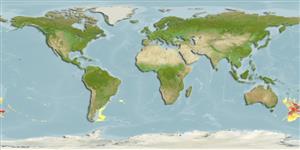Classification / Names
Common names | Synonyms | Catalog of Fishes (gen., sp.) | ITIS | CoL | WoRMS | Cloffa
Actinopterygii (ray-finned fishes) >
Perciformes (Perch-likes) >
Caristiidae (Manefishes) > Caristiinae
Etymology: Caristius: Name presumably named after Carystus, a demi-god of Greek mythology.; meridionalis: Name from Latin 'meridionalis' meaning southern, referring to the austral distribution of the species.
Environment / Climate / Range
Ecology
Marine; benthopelagic; depth range 1 - 1335 m (Ref. 94277). Subtropical, preferred ?
South Pacific: off the coasts of Australia and New Zealand. South Atlantic: off Argentina. Probably circumglobal at southern temperate latitudes.
Size / Weight / Age
Maturity: Lm ? range ? - ? cm
Max length : 26.7 cm SL male/unsexed; (Ref. 94277)
Short description
Morphology | Morphometrics
Dorsal
soft rays
(total): 35-39;
Anal
soft rays: 20 - 24;
Vertebrae: 37 - 41. This species is distinguished from its congeners by the following: have a greater number of dorsal-fin rays (35-39 or more vs. 36 or fewer); differs from C. macropus by the presence of several long bristles on distal half of raker, and one or two long bristles extending from the tip of each raker (vs. several short bristles along distal half of raker, and occasionally a small bristle at the tip) and the morphology of the dorsal pharyngeal papillae (fleshy tabs and small papillae vs. low folds); from C. fasciatus by the greater number of smaller teeth, higher vertebral count, and by the absence of a fingerlike papilla inside the opercle (occasionally absent in C. fasciatus as well); from C. digitus by the absence of a series of fingerlike papillae inside the opercle, the short conical pharyngeal teeth (vs. elongate pharyngeal teeth), and fewer gill rakers (18-21 vs. 22-26) (Ref. 94277).
Life cycle and mating behavior
Maturity | Reproduction | Spawning | Eggs | Fecundity | Larvae
Stevenson, D.E. and C.P. Kenaley, 2013. Revision of the manefish genera Caristius and Platyberyx (Teleostei: Percomorpha: Caristiidae), with description of five new species. Copeia 2013(3):415-434. (Ref. 94277)
IUCN Red List Status (Ref. 115185)
CITES (Ref. 94142)
Not Evaluated
Threat to humans
Harmless
Human uses
More information
Common namesSynonymsMetabolismPredatorsEcotoxicologyReproductionMaturitySpawningFecundityEggsEgg development
Age/SizeGrowthLength-weightLength-lengthLength-frequenciesMorphometricsMorphologyLarvaeLarval dynamicsRecruitmentAbundance
ReferencesAquacultureAquaculture profileStrainsGeneticsAllele frequenciesHeritabilityDiseasesProcessingMass conversion
Tools
Special reports
Download XML
Internet sources
